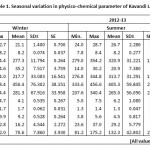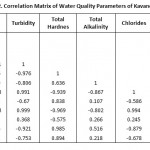Conservation Strategies for Kavandi Lake Based on Water Quality
D. D. Bhutekar1,3 * , S. B. Aher2 and M. G. Babare3
DOI: http://dx.doi.org/10.12944/CWE.9.2.20
Kavandi Lake (located at 18° 07’ N, 75° 37’ E, 530 m above MSL, in Ambad town, Maharashtra, India) was constructed by Devi Ahilyabai Holkar to fulfill the demand of drinking water for Ambad town. The physico-chemical and ecological study of the water body was conducted to assess the present status of water quality and to suggest the conservation strategies based on the findings. In order to determine the water quality, samples were collected monthly during 2012-13 from five different sampling points and analyzed for pH, EC, BOD, DO, COD, phosphates, nitrates etc. Present investigation revealed that, the urban development in the town led adverse changes in the physico-chemical and ecological characteristics of lake water. The discharge of sewage, the agricultural and urban runoff and dumping of solid waste deteriorated the water quality of lake and it is getting enriched with plant nutrients and other pollutants, becoming more and more infested with macrophytes, getting slowly shallower and shallower and shrinking gradually in size. In conclusion, the water is moderately polluted and unfit for drinking purpose without any treatment. The eutrophic condition affected the aesthetic value of lake. The best suggested strategies among conservation of lake on the basis of conducted study includes prevention of pollution, lake cleaning by de-silting, de-weeding, bioremediation, public awareness and public participation.
Copy the following to cite this article:
Bhutekar D. D, Aher S. B, Babare M. G. Conservation Strategies for Kavandi Lake Based on Water Quality. Curr World Environ 2014;9 (2) DOI:http://dx.doi.org/10.12944/CWE.9.2.20
Copy the following to cite this URL:
Bhutekar D. D, Aher S. B, Babare M. G. Conservation Strategies for Kavandi Lake Based on Water Quality. Curr World Environ 2014;9(2). Available from: http://www.cwejournal.org/?p=6151
Download article (pdf)
Citation Manager
Publish History
Select type of program for download
| Endnote EndNote format (Mac & Win) | |
| Reference Manager Ris format (Win only) | |
| Procite Ris format (Win only) | |
| Medlars Format | |
| RefWorks Format RefWorks format (Mac & Win) | |
| BibTex Format BibTex format (Mac & Win) |
Article Publishing History
| Received: | 2014-04-15 |
|---|---|
| Accepted: | 2014-05-22 |
Introduction
Water is a necessary element for endurance of living on earth, which contains minerals, essential for humans as well as for earth and aquatic life.1 The availability of good quality water is a necessary feature for preventing diseases and improving quality of life.2 Lakes have long been at the center of human attention. Lakes and surface water reservoirs are the planet’s most important freshwater resources and provide numerous benefits. They are used for domestic and irrigation purposes, and provide ecosystems for aquatic life especially fish, in that way functioning as a source of essential protein, and for significant elements of the world’s biological diversity. They have important social and economic benefits as a result of tourism and recreation, and are culturally and aesthetically3 important for people throughout the world. They also play an equally important role in flood control4 but development of human communities and increase in irresponsible use of water resources has deteriorated river and lake water qualities.5
Population growth and pollution caused by toxic waste water, surface water runoffs from municipal, industrial and agricultural sources have increased pollution load and further limited healthy water resources.6 The quality of surface water is mainly affected by natural processes (weathering and soil erosion) as well as anthropogenic inputs (municipal and industrial wastewater discharge). The anthropogenic discharges represent a constant polluting source, whereas surface runoff is a seasonal phenomenon, mainly affected by climatic conditions.7 It is well established that domestic sewage and industrial effluents falling into natural water bodies change the water quality and lead to eutrophication.8
Kavandi Lake was constructed by Devi Ahilyabai Holkar to fulfill the demand of drinking water for Ambad town. Considering the importance of the Kavandi Lake, monitoring and control of water quality is essential to conserve the ecosystem and improve management policies. The present investigation was carried out to determine the present ecological status of the Kavandi Lake and to suggest the conservation strategies based upon the observations.
Materials and Methods
Kavandi Lake is located at 18° 07’ N, 75° 37’ E, and 530 m above MSL, in Ambad town, District Jalna of Maharashtra state, India. Water samples were collected at five different sites from the lake for Physico-chemical and biological analysis. Samples were taken once every month from September 2012 to July 2013. Water samples were collected in one liter plastic bottles and collection was usually completed during morning hours between 8:00 A.M. to 10:00 A.M. For each sampling event, temperature was recorded and dissolved oxygen was fixed at the sampling sites while turbidity, pH, electrical conductivity, total dissolved solids, total alkalinity, total hardness, chloride, nitrates, phosphates, chemical oxygen demand and biological oxygen demand were analyzed in the laboratory following the standard methods described in APHA.9
Results and Discussion
The seasonal variation in the water quality parameters are presented in Table 1. and correlations among physico-chemical parameters are shown in Table2. The temperature of lake water ranged from 21.1°C to 26.7°C in different seasons. High seasonal variations were observed at all the sites. In summer, highest water temperature 28.7°C was recorded and minimum 19.5°C in winter was observed. The seasonal variation in water temperature was due to fluctuation in water level, air temperature and stability of atmosphere.10 The pH values were found 7.5-8.2 indicating alkaline nature of water throughout the study period. The high values may be due to discharge of municipal sewage and runoff from agricultural fields. It affects the growth of aquatic organisms.11 In the present study water turbidity values ranged from 20.9 to 67.0 NTU. The highest turbidity was observed in rainy season (109.0 NTU). During rainy season silt, clay and other suspended particles contribute to the turbidity values, while during winter and summer seasons settlement of silt, clay results low turbidity.12,13
|
|
Table 1: Seasonal variation in physico-chemical |
The total hardness ranged from 130.3 to 313.7 mg/l in different seasons (Table. 1). The highest total hardness 344.8 mg/l was observed in summer season with lowest in 49.8 mg/l in rainy season. The variation in total hardness was due to mass reduction by evaporation in summer and dilution by precipitation in rainy season respectively. Researchers already reported high total hardness during summer than rainy season and winter season.14 The Chlorides was recorded in the range from 265.0 mg/l to 346.9 mg/l with an average of 297.5 mg/l. The Phosphate and nitrate are the most important nutrients and a limiting factor in the maintenance of reservoir fertility and eutrophication. The phosphate and nitrate concentration of water ranged from 4.1 to 6.2 mg/l and 1.3 mg/l to 2.6 mg/l in different seasons. The high value of nitrate and phosphates are responsible for growth of macrophytes in reservoir.11
Dissolved oxygen (DO) is an important aquatic parameter, whose presence is vital to aquatic fauna. It plays crucial role in life processes of animals. In the present study the DO values found from 4.5 to 9.2 mg/l. The lower value of dissolved oxygen in summer was due to elevated temperature and higher rate of decomposition of organic matter.15 The positive co relationship between dissolved oxygen and temperature is represented in Table. 2. Biological oxygen Demand (BOD) is the oxygen required for degradation of organic matter. BOD is the real representation of quality of the water and organic load present in the water body. During the study BOD recorded from 9.4 to 29.2 mg/l which indicates the degree of water pollution. Maximum and minimum BOD value was observed in summer and rainy respectively. The higher BOD values attributed due to the organic load from discharge of municipal sewage.16 Similarly, COD values observed in the range from 68.7 to 132.3 mg/l in summer and rainy season respectively. The higher values of COD indicate pollution due to oxidisable organic matter.17 The physico-chemical parameters are interdependent and a co-relation exists among them. The temperature and pH of the water are the most influencing factors as evidenced in Table. 2.
|
|
Table 2: Correlation Matrix of Water |
Strategies for Conservation of Kavandi Lake, Ambad
The Kavandi Lake is moderately polluted due to the discharge of sewage and agricultural runoff. The conservation of the lake is essential as far as the water demand of the Ambad is concerned. The suggested strategies on the basis of obtained results are prevention of pollution by diverting or treating the municipal sewage entering the lake, lake cleaning by removing the aquatic vegetation, catchment area treatment by watershed development approach and public awareness and participation in lake conservation.
Conclusion
The study revealed that the water of Kavandi Lake is moderately polluted and unfit for drinking purpose without any treatment. The aesthetic value of lake gets deteriorated due to eutrophication in the water body. The best suggested strategies among conservation of the lake on the basis of study includes prevention of lake water pollution, treatment of sewage before discharging in lake, lake cleaning by removal of macrophytes and public awareness and public participation.
References
- Versari A., Parpinello G. P. and S. Galassi, J. Food Compos. Anal., 15, 251 (2002).
- Oluduro. A. O., Adewoye B. I., J. plant Sci., 6, 453-438 (2007).
- Kumar V. A., Sowjajanya V., Ravitra M., Gayatri P., Unnisa S. A. and Mukkanti K., IJEP, 28(9), 816-819 (2008).
- An. Y.J., Kampbell D.H., Sewell G.W., Environ. Pollut., 118, 331-336 (2002).
- Sanchez E. and Manuel F., Ecological Indicators, 7, 315–328 (2007).
- Simeonov V., Stratis J. A., Samara C., Zachariadis G., Voutsa D., Anthemidis A., Sofoniou M. and Kouimtzis Th., Water Res., 37, 4119–4124 (2003).
- Singh K. P., A. Malik., D. Mohan and S. Sinha, Water Res., 38(18), 3980-3992 (2004).
- Srivastava Neera, GarimaHarit and Rama Srivastava,Journal of Environmental Biology,30(5), 889-894 (2009).
- APHA, Standard methods for examination of water and wastewater, 21st Ed., Washington D, USA (2005).
- Sharma M. S., Liyaquat F., Barbar D. andChisty N., Poll. Res., 19(1), 147-157 (2000).
- Umavathi S., LongakumarK andSubhashini., Journal of Ecology and Environmental Conservation, 13(5), 501-504 (2007).
- Dagaonkar A. and Saksena D. N., J. Hydrobiol., 8(1), 11-19 (1992).
- Garg R. K., Saksena D. N. and Rao R. J., Journal of Ecophysiology and Occupational Health, 6, 33-40 (2006b).
- Hujare M.S., Ecotoxicology and Environmental Monitoring, 18(3), 233-242 (2008).
- Rani R., Gupta B. K. and Srivastava K. B. L., Nature environment and pollution technology, 3(4), 563-565 (2004).
- D.F. Singh and S.G. Patil, Environ. Poll. and Resource of Land and Water, 365-370 (1991).
- Rasool S., Harakishore K., Msatyakala and suryanarayanmurty U., IJEP, 2399, 961-963 (2003).








